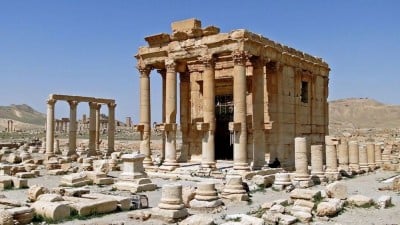Syria: How The Palmyra Victory Changes the Narrative

The liberation of Palmyra is a decisive turning point in the war on Syria. While there were earlier military successes by the Syrian Arab Army and its allies, the publicity value of securing the valued Roman ruins of Palmyra is much higher than any earlier victory. It will change some of the false narratives of the conflict.
The Syrian government is no longer “the Assad regime” and the Syrian Arab Army no longer the “Assad forces”. Ban Ki Moon, the head of the United Nations, congratulated the Syrian government to its success:
In a news conference in Jordan, Ban said he was “encouraged” that the UNESCO world heritage site is out of extremist hands and that the Syrian government “is now able to preserve and protect this human common cultural asset”.
One important part of liberating Palmyra was the use of Russian electronic warfare equipment to interfere with electromagnetic signals around Palmyra. The Islamic State rigged the ruins with improvised explosive devices but was unable to remotely detonate them.
The myth that the Syrian and Russian government are in cahoots with the Islamic State, told by various propagandist as well as the British and U.S. government, has now proven to be false. But other false claims are still made:
Lost in the celebrations was a discussion of how Palmyra had fallen in the first place. When the Islamic State captured the city in May, the militants faced little resistance from Syrian troops. At the time, residents said officers and militiamen had fled into orchards outside the city, leaving conscripted soldiers and residents to face the militants alone.
That depiction of the battle is pure nonsense. The Islamic State offensive that ended with its occupation of Palmyra took thirteen days from May 13 to May 26 2015. Heavy fighting and several Syrian army counter offensives took place during those days. After the Islamic State finally captured the city, the Syrian army immediately prepared for a larger operation to regain the city. This was launched successfully in July 2015 but for lack of air support the gains made were again lost a week later.
Throughout the 2015 fighting around Palmyra the U.S. air force, which claimed to fight the Islamic State in Iraq and Syria, did not intervene at all. ISIS was free to resupply through the open east-Syrian desert.
The sole reason that the Islamic State could successfully attack Palmyra was a very large ongoing attack by al-Qaeda Jihadists and CIA mercenary forces on the Syrian government forces in Idleb governate. The Syrian army moved troops from Palmyra to defend Idleb and Latakia and the forces left behind were no longer large enough to repel the Islamic State attack.
The attack on Idleb, for which the CIA allowed its proxy forces to directly cooperated with al-Qaeda, was supported by electronic warfare from Turkey which disrupted the Syrian military communication. The attack and the obvious cooperation between the Jihadists and Turkish and U.S. secret services was the reason that Russia and Iran decided to intervene in the conflict with their own forces. It had crossed their red line.
What followed was the roll up of all “rebels” that posed an immediate danger to the Syrian government. After Turkey ambushed a Russian jet all “rebel” forces supported by Turkey became priority targets. When the success of large scale offensives in Latakia and around Aleppo was established, Russia imposed a cease fire on the U.S. supported forces and on the Syria government. This cease fire freed up the Syrian, Iranian and Russian forces needed to successfully take back Palmyra. From there on the attack will progress eastward to Deir Ezzor and later on to Raqqa.
The Palmyra victory was the biggest defeat yet of the Islamic State. It poses a problem for the Obama administration:
Washington has endeavored to portray the battle against Islamic State as a project of the United States and its allies, while accusing Moscow of attacking “moderate” rebels instead of the extremists. Palmyra seems to embody an alternative narrative.
Congratulations, though still with loads of obligatory anti-Assad rhetoric, are now coming from unexpected corners like the conservative mayor of London:
I cannot conceal my elation as the news comes in from Palmyra and it is reported that the Syrian army is genuinely back in control of the entire Unesco site.There may be booby traps in the ruins, but the terrorists are at last on the run. Hooray, I say. Bravo – and keep going.
I concur.

